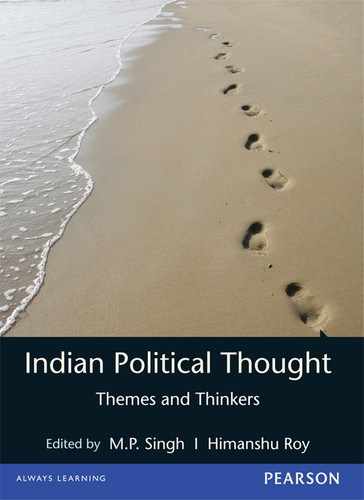Chapter 15
1. Gail Omvedt, Dalit Visions; The Anti-Caste Movement and the Construction of an Indian Identity, (New Delhi: Orient Longman, 2006), p. 61.
2. N. Velusamy, Periyar: the Social Scientist, Salem, 1999, pp. 154–155.
3. K Veeramani, Periyar and his ideologies, (Chennai: Periyar Self-respect Propaganda Institution, 1979), p. 4.
4. For instance these words of Periyar can be cited, ‘Is it not shameful on the part of such a country to aspire for Swaraj, Dominion Status or complete Independence? Politicians may say that untouchability will go if we get Swaraj. To them I say not merely Swaraj but Dharma Raj, Rama Raj, Harischandra Raj and the Raj of the very Gods—these were responsible for originating and organizing this blot on humanity.’ See Speech, ‘Revolt’—Volume 1. No. 6, Dated 12 December 1928, Erode.
5. N. Velusamy, op. cit., pp. 9–10.
6. Ibid., p. 19.
7. Ibid., p. 47.
8. Ibid., p. 42.
9. K Veeramani, Periyar’s Movement; A Short Summary, (Chennai: Dravidar Kazhagam Publications, 2002), p. 1.
10. M. D. Gopalakrishnan, Periyar; Father of the Tamil Race, (Madras: Emerald, 1991), p. 68.
11. N. Velusamy, op. cit., pp. 55–57.
12. Ibid., p.77.
13. Ibid., p. 67.
14. Ibid., p. 58.
15. Ibid., p. 59.
16. Ibid.
17. Ibid.
18. Ibid.
19. Ibid., p. 82.
20. Ibid., p. 84.
21. Ibid., pp. 108–109.
22. Ibid., pp. 116–120.
23. Collected Works of Periyar E. V. R., (ed.) Dr K Veeramani, (Chennai: The Periyar Self-Respect Propaganda Institution, 2005) (third edition), pp. 567–568.
24. Ibid., pp. 567, 569–570.
25. Ibid., pp. 570–571.
26. Ibid., p. 568–574.
27. M. D. Gopalakrishnan, op. cit., p. 61.
28. N. Velusamy, op. cit., pp. 11–17.
29. Ibid., p. 43.
30. Ibid., p. 34.
31. Ibid., p. 18.
32. Ibid., p. 23.
33. M. D. Gopalakrishnan, op. cit., p. 65.
34. K Veeramani, 1979, op. cit., p. 4.
35. M. D. Gopalakrishnan, op. cit., p. 29.
36. Collected Works of Periyar E. V. R., op.cit, pp. 367–370.
37. Ibid., p. 146.
38. Ibid., p. 147.
39. Ibid., p. 143–145.
40. Ibid., p. 152.
41. Ibid., p. 159–160.
42. Ibid., p. 163–164.
43. Ibid., p. 145.
44. Ibid., p. 161.
45. Ibid. pp. 157–158.
46. Collected Works of Periyar E. V. R., op. cit., pp. 373–377.
47. N. Velusamy, op. cit., pp. 171–173.
48. Ibid., p. 180–181.
49. Ibid., p. 181.
50. Ibid., p. 181–182.
51. Ibid., p. 173.
52. K. Veeramani, op. cit., pp. 11–12.
53. N. Velusamy, op. cit., p. 192.
54. K. Veeramani, op. cit., p. 12.
55. His prophet like demeanour, though in opposition to Godhood, must have been certainly irksome to many, as it emerges in this statement of Ravikumar, an activist—theoretician of the Dalit movement, ‘Periyar’s eccentricities seem to have provoked people to turn more zealously to religion. Tamil Nadu produces the largest number of mass circulation magazines devoted to spreading bhakti and astrology.’ Quoted in S. Anand: ‘Iconoclast, Or Lost Idol?’ Outlook, New Delhi, 20 September 2004, p. 22.
56. Velusamy, op. cit., p. 155.
57. Periyar’s use of history is problematic. To quote from Adiya Nigam, ‘He … produces a narrative of Indian history as one of the perennial struggle between the subjugated Dravidas and the subjugating Aryans. His search leads him to the discovery of the Dravida Self, which he occasionally expands to include the sudras and the atisudras of the north—an untenable exercise in terms of the canons of history in whose name the fight was being conducted. But then, there is precisely the point—it was what it has always been. It was a narrative already constituted by and therefore subordinate to the political demands of the present.’ ‘Secularism, Modernity, Nation; Epistemology of the Dalit Critique,’ EPW Special Articles, 25 November 2000s, http://epw.org.in
